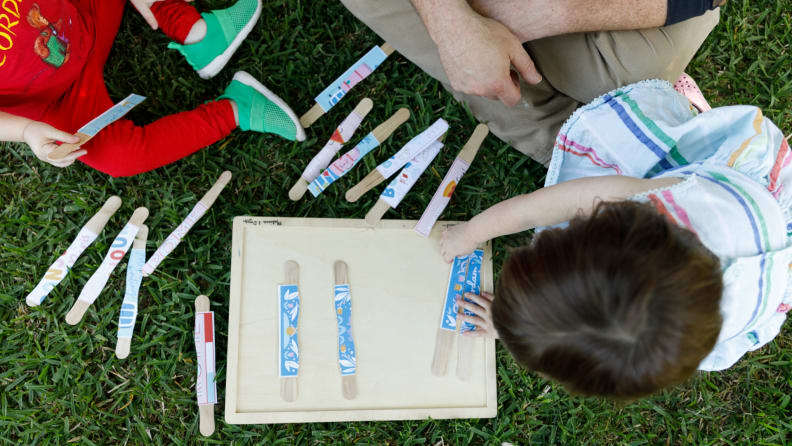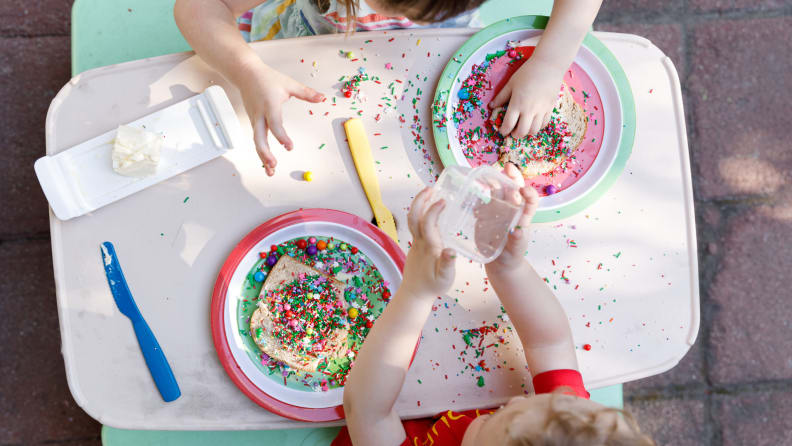Make Pinterest-worthy projects with this kids’ subscription service
 — Recommendations are independently chosen by Reviewed’s editors. Purchases you make through our links may earn us a commission.
— Recommendations are independently chosen by Reviewed’s editors. Purchases you make through our links may earn us a commission.Even the craftiest and most available parent can struggle to know what to do with their kids. And while there are seemingly a billion or so blogs out there pitching creative DIY activities, it can be a challenge to find the right ones for your kid’s age group, with the supplies you have on hand, and in a way that’s potentially building on what your child is seeing in the world around them at any given time.
Magic Playbook seeks to take some of the guesswork out of all that DIY goodness. A monthly digital print-and-play subscription service, Magic Playbook is an affordable—and adorable—list of activities to do around that month’s given theme, be it love, travel, or weather. Aimed at kids ages 2 to 6, the activities include arts and crafts, recipes, screen time suggestions, and custom sensory bins.
Magic Playbook looks amazing on the ‘gram (what doesn’t?), so we enlisted two of our own toddler testers to see what it was like in real life.
What is Magic Playbook?
Created by two moms who “know the pressure of keeping your kids busy at all times…while trying to live up to all those cute Pinterest pics,” Magic Playbook is a monthly subscription of print-and-play activities for kids that the company says should help make “motherhood easier and more fun.”
How much does Magic Playbook cost?
The cost for a monthly subscription is $11, but you can save money by selecting the annual subscription, which brings the monthly cost down to $8.25 (though you have to pre-pay the $99 yearly cost).
What’s included in a Magic Playbook subscription?

The Magic Playbook is a subscription well worth the affordable price.
On the 15th of every month, subscribers receive an email detailing that month’s theme and containing a link to that month’s playbook and printables. For May 2021, Magic Playbook collaborated with author and illustrator Audrey Smit to create a themed playbook inspired by European travel.
Inside the 30 page playbook, parents and caregivers can find a supply list, grocery list for that month’s recipes, and descriptions and photos of a number of different activities. For May, for instance, there were 24 different activities, including Airport Print & Play, Pasta Sensory Bin, Trevi Fountain Toss, and Tulip Field Dot Painting.
As part of the subscription, you’ll also have open access to Magic Playbook’s printables for that month, which include accessories and cute illustrations to enhance the play.
For instance, for Airport Print & Play, May’s kit includes cute faux-travel stickers that can be cut out and placed on a “suitcase” made out of a cardboard box you might have laying around. There’s also a drawing of an airplane window—print several to turn any room into your own personal 757—and little tags that say things like “pilot,” “flight attendant,” and “baggage claim.” Sure, you could play airport without all this stuff, but isn’t it more fun—especially for parents—if it looks cute?
Does the playbook come in the mail?
It does not. This is a fully virtual experience, and you’ll have to do all the printing and purchasing of items yourself. For this review, Magic Playbook did mail us a set of the printables printed in color on cardstock, which was great. If we were to continue the subscription, we’d probably need to make a Kinko’s run with a few activities in mind, especially since our at-home black and white printer probably wouldn’t get the job done with as much panache.
That being said, Magic Playbook does sell $15 “inspired play posters” based around each month’s theme. For May, there’s an airport check-in counter, and for April’s spring box, it’s a poster that looks like a farmer’s market booth. The posters are interactive—there’s room for them to be colored in and customized, say by adding your kid’s name to the luggage tags or stall name—and are shipped to you folded into a manila envelope.
What activities were included in our Magic Playbook?

Magic Playbook offers sensory play to stimulate your child's five senses.
Our 3-year-old toddler twins have actually been to Europe, but that doesn’t mean they remember it. Still, they like pizza and pasta well enough, so they enjoyed May activities like the pasta sensory bin and the suggested video of real chefs making wood-fired pizza.
We closed the pocket doors in our kitchen so I could set up an “airplane,” then Dada checked them—and their luggage—in and acted as flight attendant and served snacks “on the plane.” Once we “landed,” we used printable doors and windows along with good old fashioned brown paper lunch bags to make Amsterdam-style row houses, and then noshed on some Dutch-influenced sprinkle bread.
It was very weird to us American grown-ups to just eat bread with butter and sprinkles on it, especially considering the only sprinkles we had on hand were Christmas rainbow sprinkles and not the chocolate ones suggested. Our kids seemed to like it well enough—if not the actual consumption, then at the very least the act of dumping sprinkles everywhere.
Other activities, like DIY paper windmills seemed cool, but were maybe a little beyond our 3-year-olds’ creation capacity, though they did take a crack at making some Play-Doh croissants on the printable mat in the kit.
The Play-Doh mat actually made us realize that quite a few ideas in the playbook would benefit from lamination. We stupidly used a Play-Doh rolling pin to roll our dough directly onto the paper mat, for instance, and it was hell to scrape it off. If we’d laminated it first, it would have been easier to clean up, and we could reuse it down the road when we want another go-around.
We picked up a laminator afterwards, though, and used it to laminate the Landmark Block Building cards, which encourage STEM learning by showing a kid a famous building—the Arc De Triomphe, for instance—and asking them to use their own blocks to create something similar.
What we liked about Magic Playbook

What a fun and refreshing play experience for you and your child!
That Block Building is a good example of what we liked about the Magic Playbook: It reminded us what’s possible. May’s playbook may have given us these drawings of famous buildings for our kids to try and ape in their block building, but now that we have that idea in our minds, we can push it further and pull new images ourselves. Why not make Grandma’s house? Their school? The Guggenheim?
Magic Playbook gives you a great idea for an activity—a pasta sensory bin, for instance—but creative parents can take the play and push it forward, using the noodles from the bin to, say, make necklaces the next day or a different kind of sensory bin a month later.
Magic Playbook’s curated screen time lists and library lists are also amazing, just in terms of inspiration. They’re a good reminder that while "Blue’s Clues And You" is great and educational, there can also be a lot of teachable moments in a video of a behind-the-scenes tour of an airport, or on a soothing Scenery Channel tour of Amsterdam.
Magic Playbook’s library list is full of books to build on that month’s theme, but if you find a book you or your kids like, you can also investigate the author or illustrator’s other works, and you might just find a new favorite.
What we didn’t like about Magic Playbook
Like many people who work virtually now, our access to a printer can be scarce. We’re not going into an office right now where we could sneak some copies after hours, and the bare-bones printer we have at home does black and white prints only. Magic Playbook’s worksheets are so fun and colorful that, frankly, you’re going to want to print them out in color—and, in some cases, on cardstock.
If we have a complaint, that’s it: That you have to print out Magic Playbook’s content yourself and/or take it someplace to have it printed. Parents are busy, and Magic Playbook is trying to make creative play easier for you, but asking people to do an extra step or make a literal extra stop could thwart some parents who just never get around to it.
Is Magic Playbook worth it?
While the actual price of Magic Playbook is a little misleading—yes, it’s $11 for the packet, but inevitably you’ll need to buy or print something—it will be a little more than that all in.
Even then, what Magic Playbook offers is well worth the investment. With books and videos, subscribers could introduce the equivalent of a new, creative activity every day of the month, all with only the slightest amount of work on their part. Ask any hard working parent, and they’ll tell you that’s a big deal, and one that can make a huge difference.
If it can relieve even one-tenth of the stress and anxiety parents often have around keeping kids engaged, entertained, and educated, Magic Playbook just might be magic indeed.
Sign up for Magic Playbook
Related content
The product experts at Reviewed have all your shopping needs covered. Follow Reviewed on Facebook, Twitter, and Instagram for the latest deals, product reviews, and more.
Prices were accurate at the time this article was published but may change over time.


